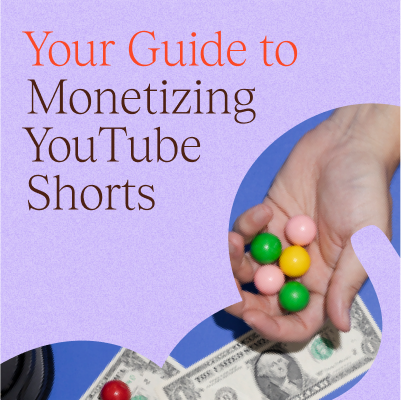If you’re a content creator, you’ve probably noticed the buzz around YouTube Shorts. Since YouTube’s short-form section launched globally in 2021, over 1.5 billion users have been watching those videos every month. And as of February 2023, YouTube has started sharing ad revenue with Shorts creators, making it one of the most attractive platforms for those looking to monetize short-form videos.
While it seems the YouTube zeitgeist has recently shifted to Shorts, as some creators are starting to see success with this new format, many still don’t know how to best use it to grow their channel.
Below, find answers to some of the burning questions about YouTube Shorts, including how the algorithm works, and how you can start using Shorts to reach more viewers.

What is the YouTube Shorts algorithm?
When creators talk about “the algorithm,” they’re talking about the secret, esoteric system pulling strings behind the scenes, subtly deciding which pieces of content get popular and which ones languish in obscurity. A lot of creators think the algorithm has it out for them, that it’s something they have to “beat” in order to get any kind of traction on YouTube. But the YouTube Shorts algorithm isn’t a sinister manipulator. Rather, it’s a system that matches up YouTube users with content it thinks they’ll want to watch.
While the specific way of how the algorithm does that isn’t always clear, giving users the right content recommendations is its ultimate goal. After all, when users enjoy the content they’re seeing, they tend to spend more time on the platform — which means generating more ad revenue for YouTube.
Bottom line: the YouTube Shorts algorithm is what determines what you see when you scroll through your Shorts feed.
Is the Shorts algorithm connected to long-form video?
The quick answer: no.
In an interview with Colin and Samir from Creator Support, YouTube employees Todd Sherman and Rene Ritchie answered the most common questions YouTube creators have about Shorts. When asked if the Shorts algorithm was connected with the algorithm used for long-form videos, Sherman made it clear that this isn’t the case — and that it hasn’t been for a while.
“When we first started out with Shorts, there were some users that really started leaning into watching them, and inadvertently their home recommendations started getting taken over by short-form video in a way that was crowding out long-form video that they would have otherwise preferred to watch,” Sherman said. “We observed that, caught it very early, and then very deliberately started separating short-form recommendations from long-form recommendations.”
So there you have it: there are completely separate algorithms governing Shorts and long-form videos on YouTube. But does that mean you should just ignore Shorts if you’re a long-form video creator? Probably not (we’ll get to it in a minute).
How does the YouTube Shorts algorithm work?
YouTube has been pretty tight-lipped when it comes to its algorithms, so the best information we have to go on comes from the few times YouTube employees have spoken openly about this topic, or from a third-party analysis. But there are some things we know for sure.
Like the algorithms of most other social media platforms, the YouTube Shorts algorithm uses various signals to make educated guesses about the kind of content a YouTube user will engage with. As long as you know what these signals are, you can make your content more algorithm-friendly.
Video topic and subject matter
Creators often worry that if their Shorts underperform, that would hurt the chance of their long-form videos being served to their audience. But that’s not the case, according to Ritchie: “We don’t look at channel or creator for those sorts of things. We look at video and topic. For example, your next video might be a banger, and it’s in nobody’s best interest to not show that video because it could be the most successful video ever.”
That means creators who want to experiment with Shorts don’t have to worry about their channel tanking just because their first short-form videos don’t turn out too well. Remember, Shorts and long-form content are governed by separate algorithms.
Video length
Paddy Galloway, a Youtube strategist who has helped clients from Red Bull to MrBeast grow their channels, recently shared the result of a massive analysis of 3.3 billion Shorts views which hint at some of the signals that matter for Shorts. One of them is video length.
From Galloway’s analysis, it’s clear that longer Shorts — hitting right up against the upper limit of 50-60 seconds — get more views. Now, that could just mean that YouTube users find longer Shorts more engaging, rather than saying anything about the algorithm. But the algorithm does care about users’ preferences, so keep this in mind.
Viewed vs. swiped away
YouTube has introduced an interesting metric for Shorts recently, which compares views that came from users who watched a Short all the way through with those that came from users that swiped away.
Galloway’s research also explores how this metric affects a Shorts’ performance. It suggests that Shorts that have a higher “Viewed” percentage perform better.
So, what can creators do about it? Essentially, you’d want to create content that encourages viewers to stick around until the end by building up anticipation (think: a punchy hook or an eye-grabbing visual to start your video). Coming up with a perfect loop for your Short can’t hurt either.
User activity and watch history
While all these signals have an impact on the algorithm, there’s one that stands above the rest: what YouTube users like to watch. With all his research, that’s the top takeaway Galloway has for creators.
So, what’s the best thing a creator can do if they want to “beat” the YouTube algorithm? Well, it’s about finding your audience and consistently creating Shorts that they’ll want to watch. And because Shorts are so much faster to create than regular YouTube videos, you can experiment with them pretty easily.
Does YouTube Shorts performance affect your long-form videos?
There’s a crucial nuance to understand when tackling this question, which Ritchie covered while discussing misconceptions about YouTube’s algorithms. “One of [the myths about the algorithm] is that the algorithm pushes videos for creators,” he said. “People think, ‘I made a video, why isn’t the algorithm pushing it?’ When in reality, the algorithm pulls videos for viewers.”
Essentially, that means while creators often think of video performance in terms of “things I can do to appease the algorithm,” they should really be focusing on their audience. They should be asking themselves what their audience wants to see, not what the algorithm needs to boost their video. That shift in mindset will help you better understand how Shorts affect your channel’s overall performance.
Should you post Shorts and long-form content on the same channel?
Good question. After all, they’re two different content formats, so it makes sense that you’d consider keeping them separated.
Well, it depends on your audience. As Pierce Vollucci, a product manager at YouTube, says in this video by Creator Insider: “Try to group your channels around similar audiences, who enjoyed the same, or similar content. Separate them out when your viewers have totally different interests.”
That means it isn’t necessary to start a new YouTube channel just for posting your Shorts content.
What if you have a Short that does really, really well?
Ritchie has the answer there too: “If we focus on the audience, the answer is more people are aware of you. More people have seen that video. And maybe when they’re on the home page and they see your next [long-form video], they’re like, ‘Oh, I recognize them from that Short,’ and the audience behavior will benefit you in the next long-form video.”
So remind yourself that you can’t put your success or failure at the foot of the algorithm. Instead, you should always be thinking about your audience.
How can you use Shorts to grow your YouTube channel?
While some creators might specialize in Shorts, most of them would want to integrate the format into their overall content strategy. Why? If there’s one trend that the team behind YouTube is noticing, it’s that posting a combination of Shorts and long-form content helps improve a channel’s growth.
“We’ve actually done some analyses recently where we looked at audience growth for channels that only made long-form videos, and channels that made both long-form and Shorts videos. The channels that made Shorts actually seem to be growing faster,” Vollucci said.
So there are signs that posting Shorts can help you grow your reach, but what exactly should you be doing with them? Since there’s no algorithm link between Shorts and long-form content, you need to think about the strengths Shorts have that long-form video can’t match, rather than worrying about what the algorithm will think.
According to Ritchie, creators can use Shorts in a number of ways. “We have to think, as creators, what is our strategy there? Are we looking at Shorts as a way to drive discovery towards our [long-form content]? Because Shorts, really, their power is in discovery,” he said. “So do we want to drive [our audience] towards long-form? Or do we want to use Shorts as a way to grow a new audience? Or do we want to use it to experiment with a new content type?”
In other words, creators should consider how Shorts can fit into their overall content strategy. And since the algorithm won’t punish you when your Shorts underperform, there’s really no risk involved.
One other thing to keep in mind: When you get good at making Shorts, your whole YouTube presence will benefit. That’s because, according to Galloway’s analysis, Shorts vastly outperform longer videos when it comes to converting viewers to subscribers.
Make the most out of YouTube Shorts
YouTube might just end up being the hottest platform for multi-faceted creators. While TikTok is great for those specialized in short-form video, it seems like the wind might be turning, and creators with a fuller skillset could potentially find better success on the older video platform. So if you’re already a YouTube creator, start experimenting with Shorts. Not only would they not hurt your long-form content, but Shorts could also help you achieve massive growth.
Now that you know how the YouTube Shorts algorithm works, you might be wondering, “How can I monetize Shorts?” Download our free YouTube Shorts Monetization Guide to learn how to turn your content into a money-making machine!
FAQ
How often should I post on YouTube Shorts?
Sure, you could publish 10 Shorts a day to maximize your chances of getting the YouTube Shorts algorithm on your side, but that’s not really going to work. You should actually be asking yourself what kind of Shorts you should be creating. That’s because, according to some creators, YouTube might actually penalize you if you create too many low-quality Shorts.
So if you’re just now getting started with YouTube Shorts, start by creating a few a week — but give it your absolute best effort.
Do you need to post a certain number of Shorts to start succeeding?
Pierce Vollucci, a product manager at YouTube, has a pretty simple answer here: “No. Every Short is given a chance to succeed no matter the channel or the number of videos on the channel. Performance of a Short is dictated by whether or not people are choosing to watch and not skip a video in the Shorts feed.”
If you don’t have any Shorts on your channel yet, don’t feel like you have to publish a bunch of them at once just to start seeing some success. Try making a few Shorts and uploading them, and let your audience’s reaction inform how you use them in the future.
How can you “beat” the YouTube Shorts algorithm?
Don’t think of the YouTube Shorts algorithm as something you need to “beat.” Its job is to match up content with people who’ll enjoy it, not to push certain creators up over others.
When speaking with Colin and Samir from the Creator Support YouTube channel, YouTube employee Rene Ritchie dispelled this misconception: “One of [the myths about the algorithm] is that the algorithm pushes videos for creators,” he said. “People think, ‘I made a video, why isn’t the algorithm pushing it?’ When in reality, the algorithm pulls videos for viewers.”
So the best way to “beat” the algorithm is to keep creating content while taking your audience’s feedback. Part of that is experimenting with different types of content to reach new subscribers.
Follow The Leap on TikTok, Instagram, and YouTube for more audience growth tips. We also make a newsletter.




